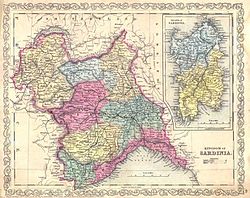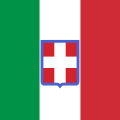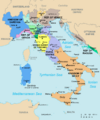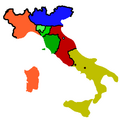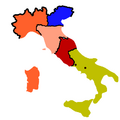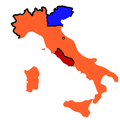Kingdom of Sardinia (1720-1861)
Topic: Place
 From HandWiki - Reading time: 15 min
From HandWiki - Reading time: 15 min
Kingdom of Sardinia | |||||||||||||||||
|---|---|---|---|---|---|---|---|---|---|---|---|---|---|---|---|---|---|
| 1324–1861 | |||||||||||||||||
Motto: FERT (Motto for the House of Savoy) | |||||||||||||||||
Anthem: S'hymnu sardu nationale "The Sardinian national anthem" | |||||||||||||||||
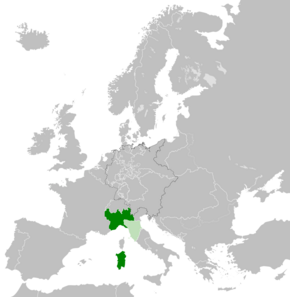 Kingdom of Piedmont-Sardinia in 1859; client state in light green | |||||||||||||||||
| Status |
| ||||||||||||||||
| Capital |
| ||||||||||||||||
| Common languages | Since the Iberian period in Sardinia: Sardinian, Corsican, Catalan and Spanish;[4] During the Savoyard period as a composite State: Also Italian (already official in the peninsula since the 16th century via the Rivoli Edict; introduced to Sardinia in 1760[5][6][7][8]), French (official in the peninsula since the 16th century via the Rivoli Edict), Piedmontese, Ligurian, Occitan and Arpitan | ||||||||||||||||
| Religion | Roman Catholicism (official)[9] | ||||||||||||||||
| Demonym(s) | Sardinian | ||||||||||||||||
| Government |
| ||||||||||||||||
| King | |||||||||||||||||
• 1324–1327 (first) | James II | ||||||||||||||||
• 1849–1861 (last) | Victor Emmanuel II | ||||||||||||||||
| Prime Minister | |||||||||||||||||
• 1848 (first) | Cesare Balbo | ||||||||||||||||
• 1860–1861 (last) | Camillo Benso | ||||||||||||||||
| Legislature | Parliament | ||||||||||||||||
| Subalpine Senate | |||||||||||||||||
| Chamber of Deputies | |||||||||||||||||
| Historical era | Late modern | ||||||||||||||||
• Papal investiture | 1297 | ||||||||||||||||
• Actual establishment | 1324 | ||||||||||||||||
• Became part of Savoy | 1720 | ||||||||||||||||
• Spanish reconquest | 1717 | ||||||||||||||||
• Became part of Savoy | 1720 | ||||||||||||||||
• Perfect fusion | 1848 | ||||||||||||||||
• Loss of Savoy and Nice | 1860 | ||||||||||||||||
• Became the new Kingdom of Italy | 1861 | ||||||||||||||||
| Population | |||||||||||||||||
• 1821 | 3,974,500[10] | ||||||||||||||||
| Currency |
| ||||||||||||||||
| |||||||||||||||||
| Today part of | Italy France Monaco | ||||||||||||||||
The Kingdom of Sardinia,[nb 1] also referred to as the Kingdom of Sardinia-Piedmont[11][12] or Piedmont-Sardinia during the Savoyard period, was a state in Southern Europe from the early 14th until the mid-19th century.
In 1720, the island was ceded by the Habsburg and Bourbon claimants to the Spanish throne to the Duke of Savoy, Victor Amadeus II. The Savoyards united it with their historical possessions on the Italian peninsula, and the kingdom came to be progressively identified with the peninsular states, which included, besides Savoy and Aosta, dynastic possessions like the Principality of Piedmont and the County of Nice, over both of which the Savoyards had been exercising their control since the 13th century and 1388, respectively.
The formal name of this composite state was the "States of His Majesty the King of Sardinia",[13] and is also referred to as Sardinia-Piedmont,[11][12] Piedmont-Sardinia, or erroneously the Kingdom of Piedmont, since the island of Sardinia had always been of secondary importance to the monarchy. Under Savoyard rule, the kingdom's government, ruling class, cultural models and center of population were entirely situated in the peninsula.[14] Therefore, while the capital of the island of Sardinia and the seat of its viceroys had always been de jure Cagliari, it was the Piedmontese city of Turin, the capital of Savoy since the mid 16th century, which was the de facto seat of power. This situation would be conferred official status with the Perfect Fusion of 1847, when all the kingdom's governmental institutions would be centralized in Turin.
When the peninsular domains of the House of Savoy were occupied and eventually annexed by Napoleonic France, the king of Sardinia temporarily resided on the island for the first time in Sardinia's history under Savoyard rule. The Congress of Vienna (1814–15), which restructured Europe after Napoleon's defeat, returned to Savoy its peninsular possessions and augmented them with Liguria, taken from the Republic of Genoa. Following Geneva’s accession to Switzerland , the Treaty of Turin (1816) transferred Carouge and adjacent areas to the newly-created Swiss Canton of Geneva. In 1847–48, through an act of Union analogous to the one between Great Britain and Ireland, the various Savoyard states were unified under one legal system with their capital in Turin, and granted a constitution, the Statuto Albertino.
By the time of the Crimean War in 1853, the Savoyards had built the kingdom into a strong power. There followed the annexation of Lombardy (1859), the central Italian states and the Two Sicilies (1860), Venetia (1866), and the Papal States (1870). On 17 March 1861, to more accurately reflect its new geographic, cultural and political extent, the Kingdom of Sardinia changed its name to the Kingdom of Italy, and its capital was eventually moved first to Florence and then to Rome. The Savoy-led Kingdom of Piedmont-Sardinia was thus the legal predecessor of the Kingdom of Italy, which in turn is the predecessor of the present-day Italian Republic.[15]
Exchange of Sardinia for Sicily
The Spanish domination of Sardinia ended at the beginning of the 18th century, as a result of the War of the Spanish succession. By the Treaty of Utrecht of 1713, Spain's European empire was divided: Savoy received Sicily and parts of the Duchy of Milan, while Charles VI (the Holy Roman Emperor and Archduke of Austria), received the Spanish Netherlands, the Kingdom of Naples, Sardinia, and the bulk of the Duchy of Milan.
During the War of the Quadruple Alliance, Victor Amadeus II, Duke of Savoy and Prince of Piedmont (and now King of Sicily too), had to agree to yield Sicily to the Austrian Habsburgs and receive Sardinia in exchange. The exchange was formally ratified in the Treaty of The Hague of 17 February 1720. Because the Kingdom of Sardinia had existed since the 14th century, the exchange allowed Victor Amadeus to retain the title of king in spite of the loss of Sicily.
Victor Amadeus initially resisted the exchange, and until 1723 continued to style himself King of Sicily rather than King of Sardinia. The state took the official title of Kingdom of Sardinia, Cyprus and Jerusalem, as the house of Savoy still claimed the thrones of Cyprus and Jerusalem, although both had long been under Ottoman rule.
In 1767–1769, Charles Emmanuel III annexed the Maddalena archipelago in the Strait of Bonifacio from the Republic of Genoa and claimed it as part of Corsica. Since then the archipelago has been a part of the Sardinian region.
Early history of Savoy
During the 3rd century BC, the Allobroges settled down in the region between the Rhône and the Alps. This region, named Allobrigia and later "Sapaudia" in Latin, was integrated to the Roman Empire. In the 5th century, the region of Savoy was ceded by the Western Roman Empire to the Burgundians and became part of the Kingdom of Burgundy.
Piedmont was inhabited in early historic times by Celto-Ligurian tribes such as the Taurini and the Salassi. They later submitted to the Romans (c. 220 BC), who founded several colonies there including Augusta Taurinorum (Turin) and Eporedia (Ivrea). After the fall of the Western Roman Empire, the region was repeatedly invaded by the Burgundians, the Goths (5th century), Byzantines, Lombards (6th century), and the Franks (773). At the time Piedmont, as part of the Kingdom of Italy within the Holy Roman Empire, was subdivided into several marks and counties.
In 1046, Oddo of Savoy added Piedmont to their main segment of Savoy, with a capital at Chambéry (now in France). Other areas remained independent, such as the powerful communes of Asti and Alessandria, and the marquisates of Saluzzo and Montferrat. The County of Savoy was elevated to a duchy in 1416, and Duke Emmanuel Philibert moved the seat to Turin in 1563.
Napoleonic Wars and the Congress of Vienna
In 1792, the Kingdom of Sardinia and the other states of the Savoy Crown joined the First Coalition against the French First Republic, but was beaten in 1796 by Napoleon and forced to conclude the disadvantageous Treaty of Paris (1796), giving the French army free passage through Piedmont. On 6 December 1798 Joubert occupied Turin and forced Charles Emmanuel IV to abdicate and leave for the island of Sardinia. The provisionary government voted to unite Piedmont with France. In 1799 the Austro-Russians briefly occupied the city, but with the Battle of Marengo (1800), the French regained control. The island of Sardinia, having defeated the armies of the French expedition to Sardinia without the royal army's help, stayed out of the reach of the French for the rest of the war.
The refusal by the Savoyards of recognizing the Sardinian's rights and representaion in government[16][17][18] caused the Sardinian Vespers (also known as the "Three years of revolution") started by sa dii de s'aciappa[19] ("the day of the pursuit and capture"), commemorated today as Sa die de sa Sardigna, when people in Cagliari started chasing any Piedmontese functionaries they could find and expelled them from the island. Thus, Sardinia became the first European country to have engaged in a revolution of its own, the episode not being the result of a foreign military importation like in most of Europe.[20]
In 1814, the Crown of Savoy enlarged its territories with the addition of the former Republic of Genoa, now a duchy, and it served as a buffer state against France. This was confirmed by the Congress of Vienna, which returned the region of Savoy to its borders after it had been annexed by France in 1792.[21] By the Treaty of Stupinigi, the Kingdom of Sardinia extended its protectorate over the Principality of Monaco.
In the reaction after Napoleon, the country was ruled by conservative monarchs: Victor Emmanuel I (1802–21), Charles Felix (1821–31) and Charles Albert (1831–49), who fought at the head of a contingent of his own troops at the Battle of Trocadero, which set the reactionary Ferdinand VII on the Spanish throne. Victor Emanuel I disbanded the entire Code Napoléon and returned the lands and power to the nobility and the Church. This reactionary policy went as far as discouraging the use of roads built by the French. These changes typified Sardinia.
The Kingdom of Sardinia industrialized from 1830 onward. A constitution, the Statuto Albertino, was enacted in the year of revolutions, 1848 under liberal pressure. In the same year the island of Sardinia, a Piedmontese dependency for more than a century, lost its own residual autonomy to the peninsula through the so-called Perfect fusion issued by Charles Albert; as a result, the kingdom's fundamental institutions were deeply transformed, assuming the shape of a constitutional and centralized monarchy on the French model; under the same pressure, Charles Albert declared war on Austria. After initial success, the war took a turn for the worse and Charles Albert was defeated by Marshal Radetzky at the Battle of Custozza (1848).
Savoyard struggle for the Italian unification
Like all the various duchies and city-states on the Apennine peninsula and associated islands, the Kingdom of Sardinia was troubled with political instability under alternating governments. After a short and disastrous renewal of the war with Austria in 1849, Charles Albert abdicated on 23 March 1849 in favour of his son Victor Emmanuel II.
In 1852, a liberal ministry under Count Camillo Benso di Cavour was installed and the Kingdom of Sardinia became the engine driving Italian unification. The Kingdom of Sardinia took part in the Crimean War, allied with the Ottoman Empire, Britain, and France, and fighting against Russia.
In 1859, France sided with the Kingdom of Sardinia in a war against Austria, the Austro-Sardinian War. Napoleon III did not keep his promises to Cavour to fight until all of the Kingdom of Lombardy–Venetia had been conquered. Following the bloody battles of Magenta and Solferino, both French victories, Napoleon thought the war too costly to continue and made a separate peace behind Cavour's back in which only Lombardy would be ceded.
Due to the Austrian government's refusal to cede any lands to the Kingdom of Sardinia, they agreed to cede Lombardy to Napoleon, who in turn then ceded the territory to the Kingdom of Sardinia to avoid "embarrassing" the defeated Austrians. Cavour angrily resigned from office when it became clear that Victor Emmanuel would accept this arrangement.
Garibaldi and the Thousand
On 5 March 1860, Piacenza, Parma, Tuscany, Modena, and Romagna voted in referendums to join the Kingdom of Sardinia. This alarmed Napoleon, who feared a strong Savoyard state on his south-eastern border and he insisted that if the Kingdom of Sardinia were to keep the new acquisitions they would have to cede Savoy and Nice to France. This was done through the Treaty of Turin, which also called for referendums to confirm the annexation. Subsequently, somewhat controversial referendums showed over 99.5% majorities in both areas in favour of joining France.[22]
In 1860, Giuseppe Garibaldi started his campaign to conquer the southern Apennines in the name of the Kingdom of Sardinia. He quickly toppled the Kingdom of the Two Sicilies, which was the largest of the states in the region, stretching from Abruzzo and Naples on the peninsula to Messina and Palermo on Sicily. He then marched to Gaeta in the central peninsula. Cavour was satisfied with the unification, while Garibaldi, who was too revolutionary for the king and his prime minister, wanted to conquer Rome as well.
Garibaldi was disappointed in this development, as well as in the loss of his home province, Nice, to France. He also failed to fulfill the promises that had gained him popular and military support by the Sicilians: that the new nation would be a republic, not a kingdom, and that the Sicilians would see great economic gains after unification. The former did not come to pass until 1946.
Towards the Kingdom of Italy
On 17 March 1861, law no. 4671 of the Sardinian Parliament proclaimed the Kingdom of Italy, so ratifying the annexations of all other Apennine states, plus Sicily, to the Kingdom of Sardinia.[23] The institutions and laws of the kingdom were quickly extended to all of Italy, abolishing the administrations of the other regions. Piedmont became the most dominant and wealthiest region in Italy and the capital of Piedmont, Turin, remained the Italian capital until 1865, when the capital was moved to Florence. But many revolts exploded throughout the peninsula, especially in southern Italy, and on the island of Sicily, because of the perceived unfair treatment of the south by the Piedmontese ruling class. The House of Savoy ruled Italy until 1946, when Italy was declared a republic by referendum. The result was 54.3% in favor of the Republic.
Currency
The currency in use in Savoy was the Piedmontese scudo. During the Napoleonic era, it was replaced in general circulation by the French franc. In 1816, after regaining their peninsular domains, the scudo was replaced by the Sardinian lira, which in 1821 also replaced the Sardinian scudo, the coins that had been in use on the island throughout the period.
Flags, royal standards and coats of arms
When the Duchy of Savoy acquired the Kingdom of Sicily in 1713 and the Kingdom of Sardinia in 1723, the flag of Savoy became the flag of a naval power. This posed the problem that the same flag was already in use by the Knights of Malta. Because of this, the Savoyards modified their flag for use as a naval ensign in various ways, adding the letters FERT in the four cantons, or adding a blue border, or using a blue flag with the Savoy cross in one canton.
Eventually, King Charles Albert of Savoy adopted the "revolutionary" Italian tricolor, surmounted by the Savoyard shield, as his flag. This flag would later become the flag of the Kingdom of Italy, and the tricolor without the Savoyard escutcheon remains the flag of Italy.
- Coats of arms
- State Flags
- Other Flags
- Royal Standards
Maps
Territorial evolution of the Kingdom of Sardinia from 1796 to 1860
- 1861:Kingdom Lombardy–VenetiaPapal States
After the Expedition of the Thousand.
See also
| Wikimedia Commons has media related to Kingdom of Sardinia. |
- List of monarchs of Sardinia
- List of viceroys of Sardinia
- Spanish Empire
- S'hymnu sardu nationale
- Kingdom of Sardinia (1324–1720)
- Kingdom of Sardinia (1700–1720)
Notes and references
Footnotes
- ↑ The name of the state was originally Latin: Regnum Sardiniae, or Regnum Sardiniae et Corsicae when the kingdom was still considered to include Corsica. In Italian it is Regno di Sardegna, in French Royaume de Sardaigne, in Sardinian Rennu de Sardigna Template:IPA-sc, and in Piedmontese Regn ëd Sardëgna [ˈrɛɲ ət sarˈdəɲːa].
Notes
- ↑ The Kingdom was initially called Regnum Sardiniae et Corsicae, in that it was originally meant to also include the neighbouring island of Corsica, until its status as a Genoese land was eventually acknowledged by Ferdinand II of Aragon, who dropped the last original bit mentioning Corsica in 1479 (Francesco Cesare, Casula. Italia, il grande inganno 1861–2011. Carlodelfino Editore. pp. 32, 49). However, every king of Sardinia continued to retain the nominal title of Rex Corsicae ("King of Corsica").
- ↑ 2.0 2.1 "Bandiere degli Stati preunitari italiani: Sardegna.". http://www.rbvex.it/sardegna.html.
- ↑ 3.0 3.1 "Flags of the World: Kingdom of Sardinia – Part 2 (Italy).". https://www.crwflags.com/fotw/flags/it-sark2.html.
- ↑ Storia della lingua sarda, vol. 3, a cura di Giorgia Ingrassia e Eduardo Blasco Ferrer
- ↑ The phonology of Campidanian Sardinian : a unitary account of a self-organizing structure, Roberto Bolognesi, The Hague : Holland Academic Graphics
- ↑ S'italianu in Sardìnnia, Amos Cardia, Iskra
- ↑ Settecento sardo e cultura europea: Lumi, società, istituzioni nella crisi dell'Antico Regime; Antonello Mattone, Piero Sanna; FrancoAngeli Storia; pp.18
- ↑ "Limba Sarda 2.0S'italianu in Sardigna? Impostu a òbligu de lege cun Boginu – Limba Sarda 2.0". Limba Sarda 2.0. http://salimbasarda.net/istoria/sitalianu-in-sardigna-impostu-a-obligu-de-lege-cun-boginu/.
- ↑ Seiwert, Hubert (2011). Religious intolerance and discrimination in selected European countries. LIT Verlag Münster. p. 166. ISBN 9783643998941. "In 1848, the Statute or constitution issued by King Carlo Alberto for the kingdom of Sardinia (better known as Piedmont, from its capital in Turin) proclaimed “the only State religion” the Roman Catholic one."
- ↑ Cummings, Jacob (1821). An Introduction to Ancient and Modern Geography. Cummings and Hilliard. p. 98. ISBN 9781341377952. https://www.google.com/books/edition/An_Introduction_to_Ancient_and_Modern_Ge/59sBAAAAYAAJ?hl=en&gbpv=0. Retrieved 11 May 2022.
- ↑ 11.0 11.1 "Sardinia-Piedmont, Kingdom of, 1848–1849". https://www.ohio.edu/chastain/rz/sard.htm.
- ↑ 12.0 12.1 "Sardinia-Piedmont | 12 | Italy in the Age of the Risorgimento 1790 – 1" (in en). doi:10.4324/9781315836836-12/sardinia-piedmont-harry-hearder. https://www.taylorfrancis.com/chapters/mono/10.4324/9781315836836-12/sardinia-piedmont-harry-hearder.
- ↑ Christopher Storrs, "Savoyard Diplomacy in the Eighteenth Century (1684–1798)", in Daniela Frigo (ed.), Politics and Diplomacy in Early Modern Italy: The Structure of Diplomatic Practice, 1450–1800 (Cambridge University Press, 2000), p. 210.
- ↑ "Sardinia, Historical Kingdom". https://www.britannica.com/place/Sardinia-historical-kingdom-Italy., Encyclopædia Britannica
- ↑ Aldo Sandulli e Giulio Vesperini (2011). "L'organizzazione dello Stato unitario" (in it). Rivista trimestrale di diritto pubblico: 47–49. http://dspace.unitus.it/bitstream/2067/1886/1/RTDP-Giulio.pdf. Retrieved 19 March 2013.
- ↑ "The resentment of the Sardinian Nation towards the Piedmontese had been growing for more than half a century, when they [Piedmontese] began to keep for themselves all the lucrative employments on the island, to violate the ancient privileges granted to the Sardinians by the Kings of Aragon, to promote to the highest positions people of their own kind while leaving to the Sardinians only the episcopates of Ales, Bosa and Castelsardo, that is Ampurias. The arrongance and scorn with which the Piedmontese had been treating the Sardinians by calling them bums, dirty, cowards and other similar and irritating names, and above all the most common expression of Sardi molenti, that is "Sardinian donkeys", did little but worsen their disposition as the days passed, and gradually alienated them from this nation." Tommaso Napoli, Relazione ragionata della sollevazione di Cagliari e del Regno di Sardegna contro i Piemontesi
- ↑ "The hostility against the Piedmontese was no longer a matter of employments, like the last period of Spanish rule, the dispatches of the viceroy Balbiano and the demands of the Stamenti may paint it out to be. The Sardinians wanted to get rid of them not only because they stood as a symbol of an anachronistic dominion, hostile to both the autonomy and the progress of the island, but also and perhaps especially because their presumptuosness and intrusiveness had already become insufferable." Raimondo Carta Raspi, Storia della Sardegna, Editore Mursia, Milano, 1971, pp.793
- ↑ "Che qualcosa bollisse in pentola, in Sardegna, poteva essere compreso fin dal 1780. Molte delle recriminazioni contro il governo piemontese erano ormai più che mature, con una casistica di atti, fatti, circostanze a sostenerle, tanto per la classe aristocratica, quanto per le altre componenti sociali." Onnis, Omar (2015). La Sardegna e i sardi nel tempo, Arkadia, Cagliari, p.149
- ↑ Sa dì de s´acciappa – Dramma storico in due tempi e sette quadri, Piero Marcialis, 1996, Condaghes
- ↑ "Mentre a Parigi si ghigliottinava Robespierre e il governo repubblicano prendeva una piega più moderata, la Sardegna era in piena rivoluzione. Primo paese europeo a seguire l'esempio della Francia, peraltro dopo averne respinto le avance militari. La rivoluzione in Sardegna, insomma, non era un fenomeno d'importazione. [...] Le rivoluzioni altrove furono suscitate dall'arrivo delle armi francesi e da esse protette (come la rivoluzione napoletana del 1799). È un tratto peculiare, quasi sempre trascurato, della nostra stagione rivoluzionaria." Onnis, Omar (2015). La Sardegna e i sardi nel tempo, Arkadia, Cagliari, p.152
- ↑ Wells, H. G., Raymond Postgate, and G. P. Wells. The Outline of History, Being a Plain History of Life and Mankind. Garden City, NY: Doubleday, 1956. p. 753
- ↑ Wambaugh, Sarah & Scott, James Brown (1920), A Monograph on Plebiscites, with a Collection of Official Documents, New York: Oxford University Press, p. 599
- ↑ Ortino, Sergio; Zagar, Mitja; Mastny, Vojtech (2005). The Changing Faces of Federalism: Institutional Reconfiguration in Europe From East to West. p. 183. ISBN 9780719069963. https://books.google.com/books?id=8Jjby--IbmMC. Retrieved 3 March 2014.
- ↑ "Flags of the World: Kingdom of Sardinia – Part 1 (Italy).". https://www.crwflags.com/fotw/flags/it-sar-k.html.
Bibliography
- Antonicelli, Aldo. "From Galleys to Square Riggers: The modernization of the navy of the Kingdom of Sardinia." The Mariner's Mirror 102.2 (2016): 153–173 online[|permanent dead link|dead link}}].
- Hearder, Harry (1986). Italy in the Age of the Risorgimento, 1790–1870. London: Longman. ISBN 0-582-49146-0.
- Luttwak Edward, The Grand Strategy of the Byzantine Empire, The Belknap Press, 2009, ISBN:9780674035195
- Martin, George Whitney (1969). The Red Shirt and the Cross of Savoy. New York: Dodd, Mead and Co.. ISBN 0-396-05908-2.
- Murtaugh, Frank M. (1991). Cavour and the Economic Modernization of the Kingdom of Sardinia. New York: Garland Publishing Inc. ISBN 9780815306719.
- Romani, Roberto. "The Reason of the Elites: Constitutional Moderatism in the Kingdom of Sardinia, 1849–1861." in Sensibilities of the Risorgimento (Brill, 2018) pp. 192–244.
- Romani, Roberto. "Reluctant Revolutionaries: Moderate Liberalism in the Kingdom of Sardinia, 1849–1859." Historical Journal (2012): 45–73. online
- Schena, Olivetta. "The role played by towns in parliamentary commissions in the kingdom of Sardinia in the fifteenth and sixteenth centuries." Parliaments, Estates and Representation 39.3 (2019): 304–315.
- Smith, Denis Mack. Victor Emanuel, Cavour and the Risorgimento (Oxford UP, 1971) online.
- Storrs, Christopher (1999). War, Diplomacy and the Rise of Savoy, 1690–1720. Cambridge University Press. ISBN 0-521-55146-3.
- Thayer, William Roscoe (1911). The Life and Times of Cavour vol 1. https://books.google.com/books?id=zfwNAQAAMAAJ. old interpretations but useful on details; vol 1 goes to 1859]; volume 2 online covers 1859–62
In Italian
- AAVV. (a cura di F. Manconi), La società sarda in età spagnola, Cagliari, Consiglio Regionale della Sardegna, 2 voll., 1992-3
- Blasco Ferrer Eduardo, Crestomazia Sarda dei primi secoli, collana Officina Linguistica, Ilisso, Nuoro, 2003, ISBN:9788887825657
- Boscolo Alberto, La Sardegna bizantina e alto giudicale, Edizioni Della TorreCagliari 1978
- Casula Francesco Cesare, La storia di Sardegna, Carlo Delfino Editore, Sassari, 1994, ISBN:8871380843
- Coroneo Roberto, Arte in Sardegna dal IV alla metà dell'XI secolo, edizioni AV, Cagliari, 2011
- Coroneo Roberto, Scultura mediobizantina in Sardegna, Nuoro, Poliedro, 2000,
- Gallinari Luciano, Il Giudicato di Cagliari tra XI e XIII secolo. Proposte di interpretazioni istituzionali, in Rivista dell'Istituto di Storia dell'Europa Mediterranea, n°5, 2010
- Manconi Francesco, La Sardegna al tempo degli Asburgo, Il Maestrale, Nuoro, 2010, ISBN:9788864290102
- Manconi Francesco, Una piccola provincia di un grande impero, CUEC, Cagliari, 2012, ISBN:8884677882
- Mastino Attilio, Storia della Sardegna Antica, Il Maestrale, Nuoro, 2005, ISBN:9788889801635
- Meloni Piero, La Sardegna Romana, Chiarella, Sassari, 1980
- Motzo Bachisio Raimondo, Studi sui bizantini in Sardegna e sull'agiografia sarda, Deputazione di Storia Patria della Sardegna, Cagliari, 1987
- Ortu Gian Giacomo, La Sardegna dei Giudici, Il Maestrale, Nuoro, 2005, ISBN:9788889801024
- Paulis Giulio, Lingua e cultura nella Sardegna bizantina: testimonianze linguistiche dell'influsso greco, Sassari, L'Asfodelo, 1983
- Spanu Luigi, Cagliari nel seicento, Edizioni Castello, Cagliari, 1999
- Zedda Corrado – Pinna Raimondo, La nascita dei Giudicati. Proposta per lo scioglimento di un enigma storiografico, in Archivio Storico Giuridico di Sassari, seconda serie, n° 12, 2007
 KSF
KSF



